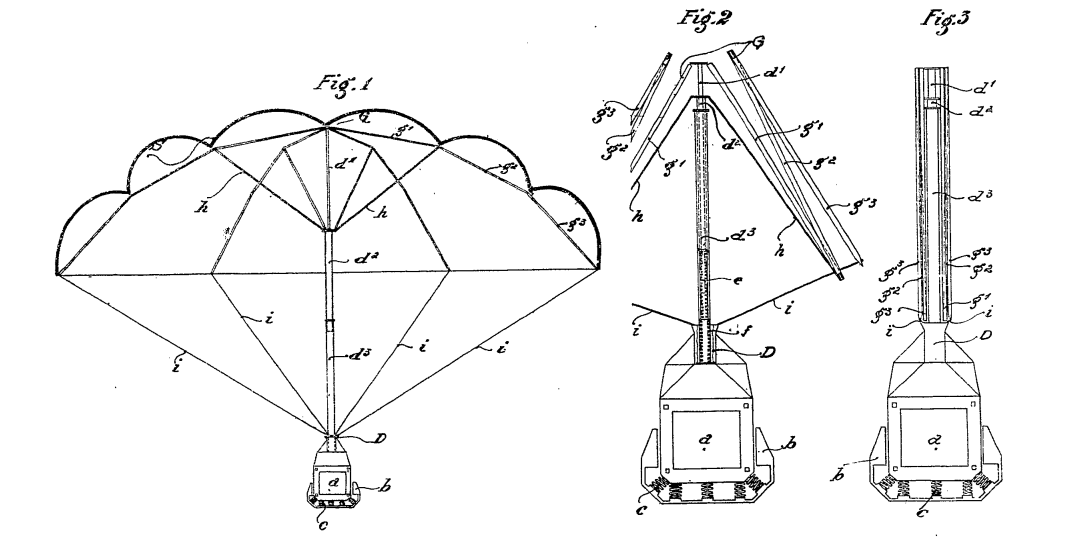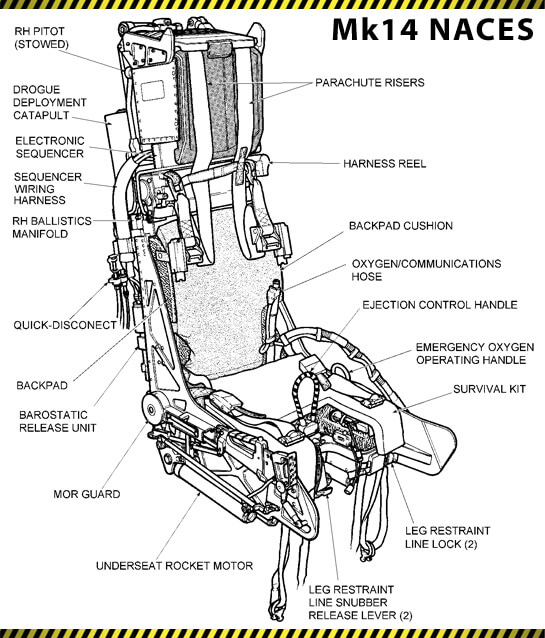Ejector Seats: The Rocket Chairs That Save Lives [Hackaday]

Once upon a time, escaping an aircraft was a tricky business. You had to unstrap yourself, fling open a heavy glass canopy, and try to wrench yourself out of a small opening without getting smacked by the tail or chopped up by the propeller. Many pilots failed this difficult task, to the tragic loss of their lives.
Eventually, the human cost was heavy enough and militaries grew strained at having to train new pilots to replace the experienced ones lost to accidents and enemy fire. The ejection seat was developed to make escaping a plane as simple as tucking yourself in and pulling a big red handle. Let’s dive in and learn how it came to be.
EJECT! EJECT!

Ejector seats are a marvel of engineering that turned the tide for pilot safety in the mid-20th century. They’re just another arm of the relentless pursuit of innovation in aviation. They emerged from the necessity to provide a quick and reliable escape mechanism for expensive, highly-trained pilots. They quickly became an invaluable asset to air forces across the world, particularly with the development of ever faster military aircraft. Before ejector seats, pilots had to manually bail out of their aircraft, a risky and often fatal endeavor complicated by high speeds or low altitudes. The advent of the ejector seat was a groundbreaking development, offering a glimmer of hope in the otherwise perilous domain of aerial combat.

The earliest attempts at creating an ejector seat were as rudimentary as they were daring. Early ideas began to spawn shortly after the development of the aircraft; one such idea from inventor Everard Calthrop in 1916 involved using compressed air to eject a parachute that would then pull the pilot from the airplane. A concept more akin to the modern idea of an ejection seat was later pioneered by Romanian Anastase Dragomir towards the end of the 1920s. He was able to test his idea of a “catapulted cabin” in Paris in 1929, securing patents along the way for his idea.
World War II would become the real impetus for the development of the ejector seat, however. At the time, pilots and crews of military aircraft were limited to desperately clambering out of a faltering, damaged airplane, ideally quickly enough that they could pull the chute with enough altitude left to slow down before hitting the ground. Aircraft designers at Heinkel and Saab independently recognized the dire need for a safe escape mechanism, and began to develop primitive ejector seats. These early models were far from the sophisticated systems we know today, but they laid the foundation for a technology that would evolve dramatically over the ensuing decades. The concept of an ejector seat, however, was not just a product of wartime necessity. It was also a reflection of the rapid advancements in aircraft speed and altitude, which made traditional methods of escape increasingly impractical and dangerous.

The core principle of an ejector seat is relatively straightforward: to propel the pilot out of the aircraft to a safe distance, where they can deploy a parachute and descend to the ground. The mechanism behind this life-saving device is a blend of precise engineering and controlled explosive power. At its heart lies a compressed air system, rocket, or an explosive charge, which, when activated, rapidly generates enough force to eject the seat and its occupant from the aircraft. This process must be meticulously timed and executed, as even a split-second delay can mean the difference between life and death. Indeed, it’s not just about the seat itself, either. The ejector seat is necessarily paired with other explosive devices that eject the canopy or other parts of the aircraft out of the way prior to launching the pilot to safety.
The whole process must take place with perfect timing, and it all happens in mere seconds. The canopy is blown off first, before the pilot is launched clear by the pyrotechnics. What happens next depends on the situation. If the ejection was at particularly high altitude, the seat falls for some time before deploying the full parachute to reach a safer altitude where the air is thicker. Alternatively, if the ejection was at low altitude, the parachute is opened shortly after leaving the aircaft.

The earliest models of ejection seat that saw real use were fitted to some of the more obscure German planes used in the war. The first ejection from a damaged aircraft was by Helmut Schenk, a test pilot flying the Heinkel He 280. During a test flight in early 1942, Schenk found his controls iced up and unresponsive, and chose to abandon the aircraft using the rudimentary ejection seat powered by compressed air. Later models from Heinkel used a seat that used wheels that ran on two pipes like rails in the back of the cockpit. The seat also featured caps that sealed over the ends of those pipes. Explosive charges placed into those pipes could be fired to eject the seat, as the gases produced blew the caps off, forcing the seat upwards and carrying the pilot, ideally, to safety.
Explosive charges remained a common method of designing ejection seats, but the technology ran into a hitch as aircraft flew ever faster. Faster planes needed ejection seats that could more quickly clear the pilot from the plane. The problem was that the shock loading of a rapid explosive release of gas was hard on a pilot’s spine, and increasing this further wasn’t possible without causing excessive injury. Rocket propelled seats would eventually become the norm, providing a smoother, more continuous acceleration to the seat, and thus, the pilot. The first was fitted to the Convair F-102 Delta Dagger in 1958.
Better and Better
In its evolution, the ejector seat has seen numerous innovations. Early models were limited to a certain performance envelope in which they were effective. Pilots were educated on the minimum altitude and maximum speed limits at which their ejector seat would be effective. Eventually, seats improved, with one of the key developments being the introduction of a zero-zero capability. This means the seat can be used effectively even when the aircraft is stationary and at sea level. More modern developments have seen the integration of advanced sensors and automated systems further enhanced the reliability and safety of ejector seats. These systems are capable of detecting the aircraft’s condition and automatically initiating the ejection sequence if the pilot is incapacitated or unable to do so.
Modern ejector seats are also designed with human ergonomics in mind. They must accommodate a wide range of pilot sizes and weights, ensuring that the ejection process is as safe as possible for all occupants. This consideration extends to the forces exerted on the pilot during ejection, which can be immense. Manufacturers have continuously refined their designs to minimize the risk of injury from the ejection process itself. It bears noting that an ejection is still often a highly dangerous and intense event for a pilot. Modern Western ejection seats subject the pilot to forces on the order of 12-14 G. Earlier Soviet designs have been stated to be even more aggressive, often from 20-22 G. Injuries to the spine are common, and it’s not unheard of for pilots to suffer dislocations or broken bones in the tumult of an ejection from a stricken aircraft.

Another critical component in an ejection seat is the personal survival pack, designed to keep the pilot alive in for the immediate future. This includes a basic gear like a radio, first aid supplies, water and food rations, and usually a life raft in case the plane goes down over water. In the Western world, the most famous ejection seat manufacturer is Martin-Baker, which maintains an exclusive club of pilots who have had to rely on their products in an emergency situation. The Ejection Tie Club, as it is known, is full of members who can speak of the challenge of clambering into a life raft after having pulled the ejection handles and fallen out of the sky in dramatic fashion.
An ejection seat is, today, considered a vital life saving device in many military aircraft. At times, the technology has even become an ethical and political sore point. Britain faced a crisis in the Royal Air Force in the 1950s and 1960s when V-bomber pilots had access to ejection seats, while their support crews had to bail out by hand. Fatal accidents put a black mark on the aircraft, and air crews would share dark jokes about expecting the pilots to go down with the rest of the crew if the worst were to occur. The case of the V-Bombers highlighted just how much ejector seats had changed military aviation. Pilots had grown to expect a high-tech escape system to evacuate their aircraft in a crisis. Other crew members on larger aircraft like bombers often weren’t so lucky. It lead to the development of large escape capsules for some aircraft like the General Dynamics F-111, or provision for multiple ejection seats for crew in planes like the Rockwell B1.
In the end, the story of the ejector seat is one of continual improvement and adaptation. From its crude beginnings in World War II to the high-tech marvels found in today’s advanced fighter jets, ejector seats represent a fascinating intersection of necessity, innovation, and technology. They not only save lives but also embody the relentless human spirit to push the boundaries of what’s possible in aviation safety. As aircraft continue to evolve, so too will the ejector seats, ensuring that pilots have the best possible chance of survival in the most extreme circumstances.

![ejector-seats:-the-rocket-chairs-that-save-lives-[hackaday]](https://i0.wp.com/upmytech.com/wp-content/uploads/2023/11/155064-ejector-seats-the-rocket-chairs-that-save-lives-hackaday-scaled.jpg?resize=800%2C445&ssl=1)